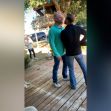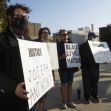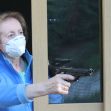When a man wearing a ski mask and black clothing entered a Houston Mexican restaurant, he demanded money from patrons. With his arm stretched in front of him, he held something that looked like a gun, so patrons threw money on the floor or hid under tables as he walked through the dining room.
The masked man picked up the money, and eventually headed toward the front of the restaurant, with his arm still held out with that item that looked like a weapon. It was then that a diner sitting in a booth took out his own gun and shot the intruder nine times, killing him.
After the shooting, all the customers in the restaurant fled the chaotic scene. Houston authorities arrived and found alleged thief Eric Eugene Washington, 30, dead on the tile floor.
But Washington, whom diners believed had been brandishing a gun in his outstretched hand, had been carrying something quite different: a plastic toy gun.
Armed with explicit video footage, the police acted to locate the diners. Since the patrons had all fled after the restaurant shooting and Houston police did not know who had shot Washington, they published restaurant surveillance photos, showing the shooter/patron holding his gun.
That still unidentified patron, 46, spoke with the Houston police as requested, and was not charged or arrested with any crime.
However, authorities announced shortly afterward that there will be a Grand Jury in Harris County, signifying a possible case against the diner/shooter who killed the intruder at the El Rancho #4 restaurant.
The police said witnesses from the scene said the intruder pointed his “pistol” at the patrons and demanded money from them. The shooter/patron did leave money for Washington on the floor by his booth. But when Washington walked by again, headed for the front door, the shooter/patron took out his gun and fired.
Video surveillance shows the shooter/patron shooting Washington rapidly, four times. When Washington fell to the floor after being shot, the unnamed shooter/patron then stood up, walked toward the fallen intruder, and shot him four more times. Once the shooter/patron reached the body of the intruder, he stood directly over him and shot him the ninth time, at close range.
Although the shooter/patron does not deny his shooting the intruder, a Grand Jury may mean he will face charges. In Texas, however, the law is clear. Anyone can use deadly force legally if they deem it "immediately necessary to protect the actor against the other's use or attempted use of unlawful force.”
Using deadly force as self-defense would be a powerful defense strategy for the unnamed shooter/patron if he is charged with any crimes by the Grand Jury.
Texas has a “Stand your Ground” law in effect with strong self-defense rights, including rendering any citizen’s “duty to retreat” null and void if faced with someone deemed a credible threat to their safety. Nathan Beedle of the Harris County District Attorney’s Office said the law is clear about the rights of citizens using deadly force against a threat by an actor.
"Whether someone uses deadly force in the situation, that is presumed to be correct under Texas law,” said Beedle, in a televised interview.
Though no one might dispute the fact that the man brandishing what looked like a gun was a threat to the diners’ safety, one fact may lead to charges. The “Stand Your Ground” law states that in Texas, if anyone believes force, including deadly force, is necessary to keep them safe, it is legal to fight back or shoot the dangerous actor.
But in this case, the shooter/patron did not shoot until Washington was already walking toward the front door. Was he leaving? Was he still a threat?
The Grand Jury may determine that the shooter/patron did not act in self-defense, since Washington was on his way out of the Mexican restaurant.
Video surveillance, which has now been shared on social media over 15 million times, shows the shooter/patron taking back the money from Washington’s body and also grabbing the intruder’s “gun” and throwing it across the room while yelling.
Two points can be used by the defense and prosecution here.
For the defense, it’s obvious that the shooter/patron believed it was a real gun he flung across the room.
But the prosecutor may argue that the shooter/patron, who had already shot the intruder eight times, did not have to stand over his lifeless body and shoot him a ninth time.
Also, the fact that the gun was plastic may raise legal questions. Texas local news KPRC 2 legal analyst Brian Wice said the fake gun looked real to the patrons, so it was a reasonable threat to them and the shooter/patron.
“The fact that this perpetrator had a fake gun makes no difference,” Wice said. “Everybody who was present that night, including the shooter, had no way of knowing. Once he fires that first shot, if his belief was reasonable, that belief continues until the threat has been totally dissipated.”
The attorney for the unnamed shooter/patron agrees.
“My client, who wishes to remain anonymous, was dining with a friend at El Ranchito Taqueria and as it has been seen on video a robbery suspect entered the restaurant, pointed a weapon at my client and the other customers demanding money. In fear of his life and his friend’s life, my client acted to protect everyone in the restaurant. In Texas, a shooting is justified in self-defense, defense of others and in defense of property. We are confident that a grand jury will conclude that the shooting was justified under Texas law. This event has been very traumatic, taking a human life is something he does not take lightly and will burden him for the rest of his life. For that reason, he wishes to remain anonymous.”






